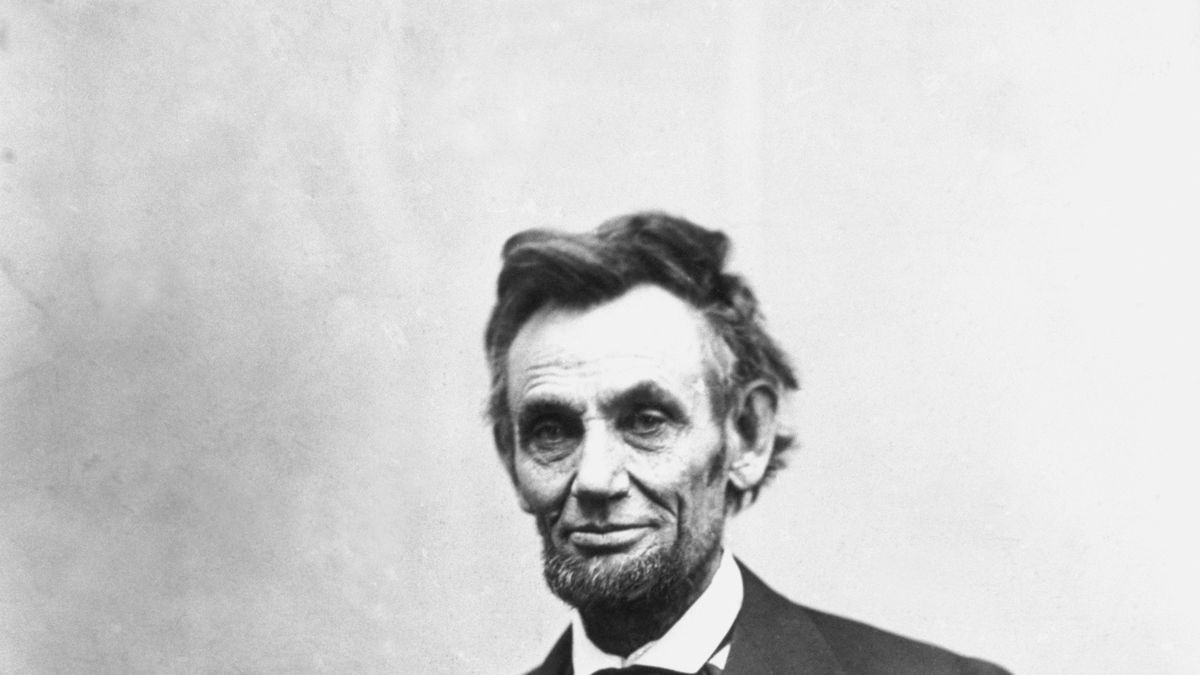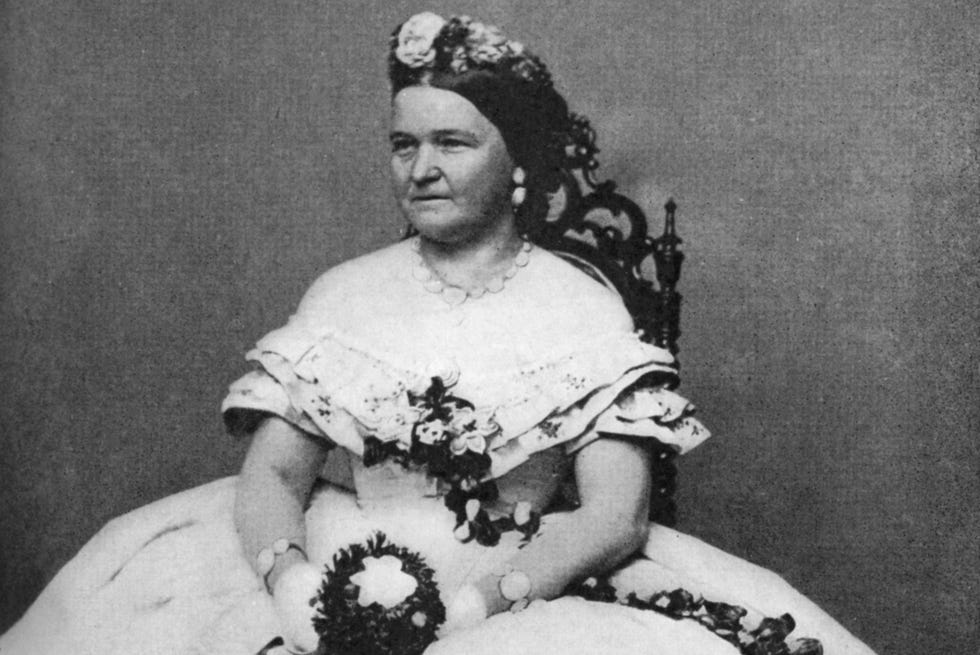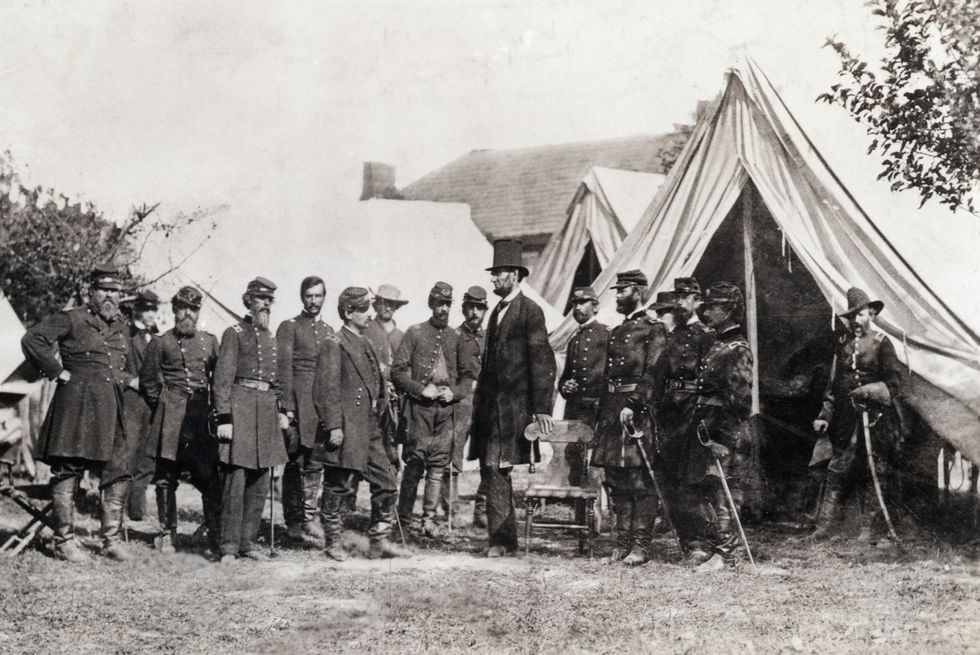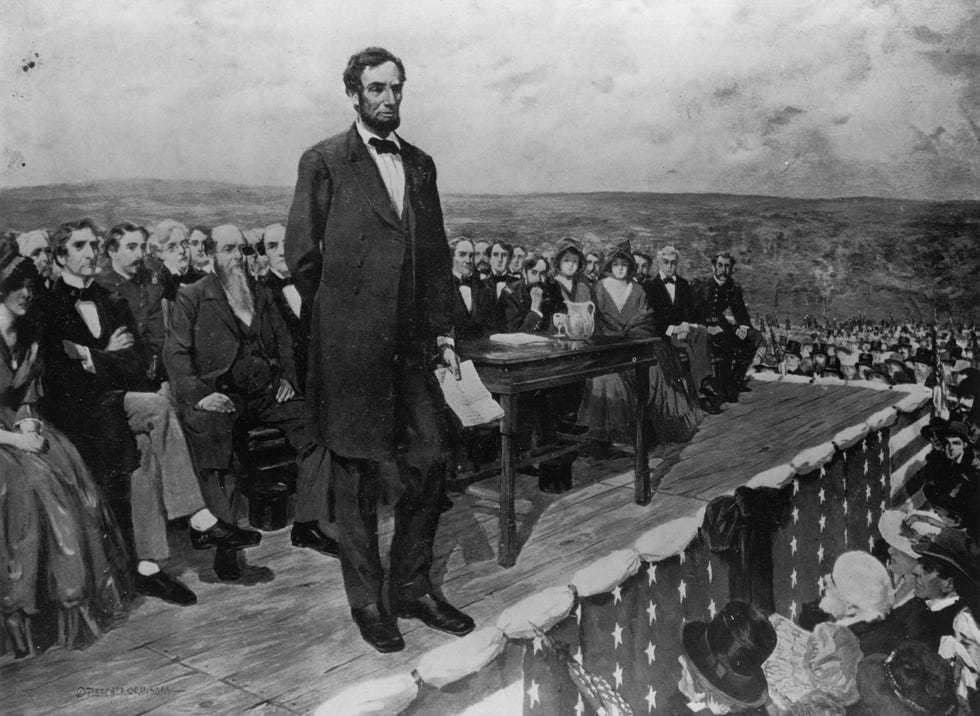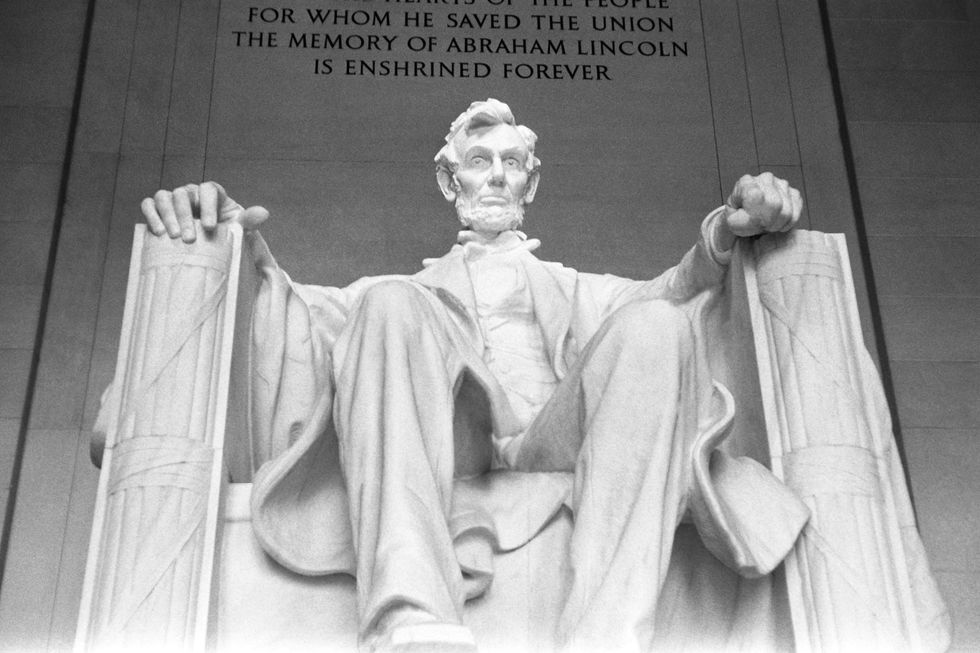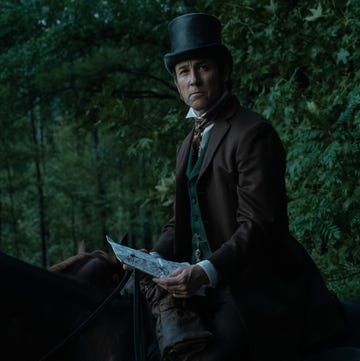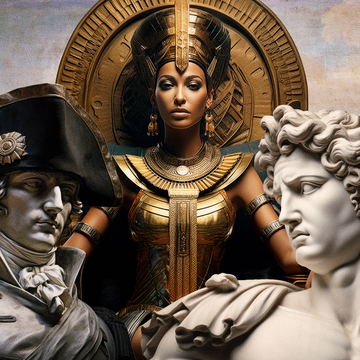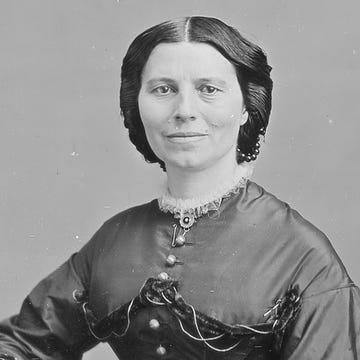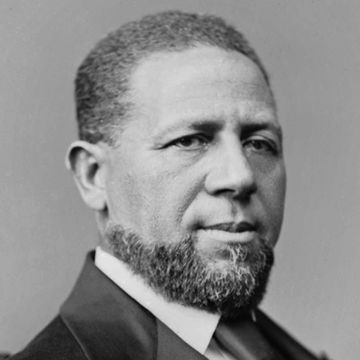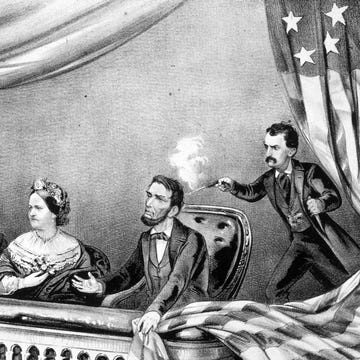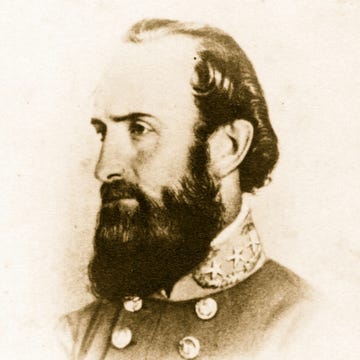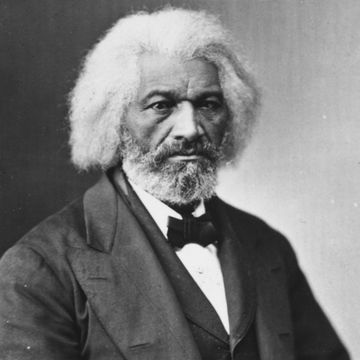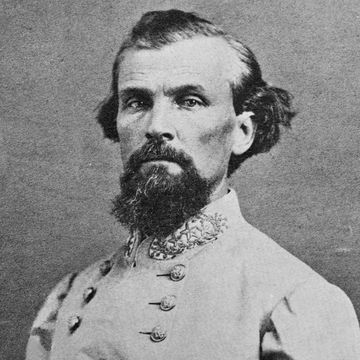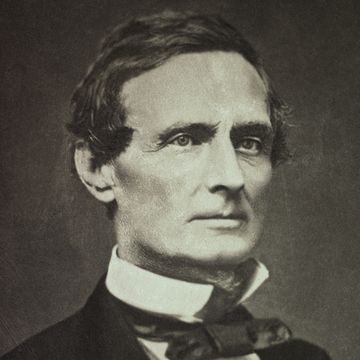Jump to:
- Who Was Abraham Lincoln?
- Quick Facts
- Early Life, Parents, and Education
- How Tall Was Abraham Lincoln?
- Wrestling Hobby and Legal Career
- Wife and Children
- Political Career
- Lincoln and Slavery
- Senate Race
- U.S. President
- Civil War Begins
- Emancipation Proclamation
- Gettysburg Address
- Civil War Ends and Lincoln’s Reelection
- Assassination and Funeral
- Abraham Lincoln’s Hat
- Legacy
- Abraham Lincoln in Movies and TV
- Quotes
1809-1865
Who Was Abraham Lincoln?
Abraham Lincoln was the 16th president of the United States, serving from 1861 to 1865, and is regarded as one of America’s greatest heroes due to his roles in guiding the Union through the Civil War and working to emancipate enslaved people. His eloquent support of democracy and insistence that the Union was worth saving embody the ideals of self-government that all nations strive to achieve. In 1863, he issued the Emancipation Proclamation, which freed slaves across the Confederacy. Lincoln’s rise from humble beginnings to achieving the highest office in the land is a remarkable story, and his death is equally notably. He was assassinated by John Wilkes Booth in 1865, at age 56, as the country was slowly beginning to reunify following the war. Lincoln’s distinctively humane personality and incredible impact on the nation have endowed him with an enduring legacy.
Quick Facts
FULL NAME: Abraham Lincoln
BORN: February 12, 1809
DIED: April 15, 1865
BIRTHPLACE: Hodgenville, Kentucky
SPOUSE: Mary Todd Lincoln (m. 1842)
CHILDREN: Robert Todd Lincoln, Edward Baker Lincoln, William Wallace Lincoln, and Thomas “Tad” Lincoln
ASTROLOGICAL SIGN: Aquarius
HEIGHT: 6 feet 4 inches
Early Life, Parents, and Education
Abraham Lincoln was born on February 12, 1809, to parents Thomas Lincoln and Nancy Hanks Lincoln in rural Hodgenville, Kentucky.
Thomas was a strong and determined pioneer who found a moderate level of prosperity and was well respected in the community. The couple had two other children: Lincoln’s older sister, Sarah, and younger brother, Thomas, who died in infancy. His death wasn’t the only tragedy the family would endure.
In 1817, the Lincolns were forced to move from young Abraham’s Kentucky birthplace to Perry County, Indiana, due to a land dispute. In Indiana, the family “squatted” on public land to scrap out a living in a crude shelter, hunting game and farming a small plot. Lincoln’s father was eventually able to buy the land.
When Lincoln was 9 years old, his 34-year-old mother died of tremetol, more commonly known as milk sickness, on October 5, 1818. The event was devastating to the young boy, who grew more alienated from his father and quietly resented the hard work placed on him at an early age.
In December 1819, just over a year after his mother’s death, Lincoln’s father Thomas married Sarah Bush Johnston, a Kentucky widow with three children of her own. She was a strong and affectionate woman with whom Lincoln quickly bonded.
Although both his parents were most likely illiterate, Thomas’ new wife Sarah encouraged Lincoln to read. It was while growing into manhood that Lincoln received his formal education—an estimated total of 18 months—a few days or weeks at a time.
Reading material was in short supply in the Indiana wilderness. Neighbors recalled how Lincoln would walk for miles to borrow a book. He undoubtedly read the family Bible and probably other popular books at that time such as Robinson Crusoe, Pilgrim’s Progress, and Aesop’s Fables.
In March 1830, the family again migrated, this time to Macon County, Illinois. When his father moved the family again to Coles County, 22-year-old Lincoln struck out on his own, making a living in manual labor.
How Tall Was Abraham Lincoln?
Lincoln was 6 feet 4 inches tall, rawboned and lanky yet muscular and physically strong. He spoke with a backwoods twang and walked with a long-striding gait. He was known for his skill in wielding an ax and early on made a living splitting wood for fire and rail fencing.
Wrestling Hobby and Legal Career
Young Lincoln eventually migrated to the small community of New Salem, Illinois, where over a period of years he worked as a shopkeeper, postmaster, and eventually general store owner. It was through working with the public that Lincoln acquired social skills and honed a storytelling talent that made him popular with the locals.
Not surprising given his imposing frame, Lincoln was an excellent wrestler and had only one recorded loss—to Hank Thompson in 1832—over a span of 12 years. A shopkeeper who employed Lincoln in New Salem, Illinois, reportedly arranged bouts for him as a way to promote the business. Lincoln notably beat a local champion named Jack Armstrong and became somewhat of a hero. (The National Wrestling Hall of Fame posthumously gave Lincoln its Outstanding American Award in 1992.)
When the Black Hawk War broke out in 1832 between the United States and Native Americans, the volunteers in the area elected Lincoln to be their captain. He saw no combat during this time, save for “a good many bloody struggles with the mosquitoes,” but was able to make several important political connections.
As he was starting his political career in the early 1830s, Lincoln decided to become a lawyer. He taught himself the law by reading William Blackstone’s Commentaries on the Laws of England. After being admitted to the bar in 1837, he moved to Springfield, Illinois, and began to practice in the John T. Stuart law firm.
In 1844, Lincoln partnered with William Herndon in the practice of law. Although the two had different jurisprudent styles, they developed a close professional and personal relationship.
Lincoln made a good living in his early years as a lawyer but found that Springfield alone didn’t offer enough work. So to supplement his income, he followed the court as it made its rounds on the circuit to the various county seats in Illinois.
Wife and Children
On November 4, 1842, Lincoln wed Mary Todd, a high-spirited, well-educated woman from a distinguished Kentucky family. Although they were married until Lincoln’s death, their relationship had a history of instability.
When the couple became engaged in 1840, many of their friends and family couldn’t understand Mary’s attraction; at times, Lincoln questioned it himself. In 1841, the engagement was suddenly broken off, most likely at Lincoln’s initiative. Mary and Lincoln met later at a social function and eventually did get married.
The couple had four sons—Robert Todd, Edward Baker, William Wallace, and Thomas “Tad”—of whom only Robert survived to adulthood.
Before marrying Todd, Lincoln was involved with other potential matches. Around 1837, he purportedly met and became romantically involved with Anne Rutledge. Before they had a chance to be engaged, a wave of typhoid fever came over New Salem, and Anne died at age 22.
Her death was said to have left Lincoln severely depressed. However, several historians disagree on the extent of Lincoln’s relationship with Rutledge, and his level of sorrow at her death might be more the makings of legend.
About a year after the death of Rutledge, Lincoln courted Mary Owens. The two saw each other for a few months, and marriage was considered. But in time, Lincoln called off the match.
Political Career
In 1834, Lincoln began his political career and was elected to the Illinois state legislature as a member of the Whig Party. More than a decade later, from 1847 to 1849, he served a single term in the U.S. House of Representatives. His foray into national politics seemed to be as unremarkable as it was brief. He was the lone Whig from Illinois, showing party loyalty but finding few political allies.
As a congressman, Lincoln used his term in office to speak out against the Mexican-American War and supported Zachary Taylor for president in 1848. His criticism of the war made him unpopular back home, and he decided not to run for second term. Instead, he returned to Springfield to practice law.
By the 1850s, the railroad industry was moving west, and Illinois found itself becoming a major hub for various companies. Lincoln served as a lobbyist for the Illinois Central Railroad as its company attorney.
Success in several court cases brought other business clients as well, including banks, insurance companies, and manufacturing firms. Lincoln also worked in some criminal trials.
In one case, a witness claimed that he could identify Lincoln’s client who was accused of murder, because of the intense light from a full moon. Lincoln referred to an almanac and proved that the night in question had been too dark for the witness to see anything clearly. His client was acquitted.
Lincoln and Slavery
As a member of the Illinois state legislature, Lincoln supported the Whig politics of government-sponsored infrastructure and protective tariffs. This political understanding led him to formulate his early views on slavery, not so much as a moral wrong, but as an impediment to economic development.
In 1854, Congress passed the Kansas-Nebraska Act, which repealed the Missouri Compromise, allowing individual states and territories to decide for themselves whether to allow slavery. The law provoked violent opposition in Kansas and Illinois, and it gave rise to today’s Republican Party.
This awakened Lincoln’s political zeal once again, and his views on slavery moved more toward moral indignation. Lincoln joined the Republican Party in 1856.
In 1857, the Supreme Court issued its controversial Dred Scott decision, declaring Black people were not citizens and had no inherent rights. Although Lincoln felt Black people weren’t equal to whites, he believed America’s founders intended that all men were created with certain inalienable rights.
Senate Race
Lincoln decided to challenge sitting U.S. Senator Stephen Douglas for his seat. In his nomination acceptance speech, he criticized Douglas, the Supreme Court, and President James Buchanan for promoting slavery then declared “a house divided cannot stand.”
During Lincoln’s 1858 U.S. Senate campaign against Douglas, he participated in seven debates held in different cities across Illinois. The two candidates didn’t disappoint, giving stirring debates on issues such as states’ rights and western expansion. But the central issue was slavery.
Newspapers intensely covered the debates, often times with partisan commentary. In the end, the state legislature elected Douglas, but the exposure vaulted Lincoln into national politics.
U.S. President
With his newly enhanced political profile, in 1860, political operatives in Illinois organized a campaign to support Lincoln for the presidency. On May 18, at the Republican National Convention in Chicago, Lincoln surpassed better-known candidates such as William Seward of New York and Salmon P. Chase of Ohio. Lincoln’s nomination was due, in part, to his moderate views on slavery, his support for improving the national infrastructure, and the protective tariff.
In the November 1860 general election, Lincoln faced his friend and rival Stephen Douglas, this time besting him in a four-way race that included John C. Breckinridge of the Northern Democrats and John Bell of the Constitution Party. Lincoln received not quite 40 percent of the popular vote but carried 180 of 303 Electoral College votes, thus winning the U.S. presidency. He grew his trademark beard after his election.
Lincoln’s Cabinet
Following his election to the presidency in 1860, Lincoln selected a strong cabinet composed of many of his political rivals, including William Seward, Salmon P. Chase, Edward Bates, and Edwin Stanton.
Formed out the adage “Hold your friends close and your enemies closer,” Lincoln’s cabinet became one of his strongest assets in his first term in office, and he would need them as the clouds of war gathered over the nation the following year.
Civil War Begins
Before Lincoln’s inauguration in March 1861, seven Southern states had seceded from the Union, and by April, the U.S. military installation Fort Sumter was under siege in Charleston Harbor, South Carolina. In the early morning hours of April 12, 1861, the guns stationed to protect the harbor blazed toward the fort, signaling the start of the U.S. Civil War, America’s costliest and bloodiest war.
The newly President Lincoln responded to the crisis wielding powers as no other president before him: He distributed $2 million from the Treasury for war material without an appropriation from Congress; he called for 75,000 volunteers into military service without a declaration of war; and he suspended the writ of habeas corpus, allowing for the arrest and imprisonment of suspected Confederate States sympathizers without a warrant.
Crushing the rebellion would be difficult under any circumstances, but the Civil War, after decades of white-hot partisan politics, was especially onerous. From all directions, Lincoln faced disparagement and defiance. He was often at odds with his generals, his cabinet, his party, and a majority of the American people.
Emancipation Proclamation
On January 1, 1863, Lincoln delivered his official Emancipation Proclamation, reshaping the cause of the Civil War from saving the Union to abolishing slavery.
The Union Army’s first year and a half of battlefield defeats made it difficult to keep morale high and support strong for a reunification of the nation. And the Union victory at Antietam on September 22, 1862, while by no means conclusive, was hopeful. It gave Lincoln the confidence to officially change the goals of the war. On that same day, he issued a preliminary proclamation that slaves in states rebelling against the Union would be free as of January 1.
The Emancipation Proclamation stated that all individuals who were held as enslaved people in rebellious states “henceforward shall be free.” The action was more symbolic than effective because the North didn’t control any states in rebellion, and the proclamation didn’t apply to border states, Tennessee, or some Louisiana parishes.
As a result, the Union army shared the Proclamation’s mandate only after it had taken control of Confederate territory. In the far reaches of western Texas, that day finally came on June 19, 1865—more than two and a half years after the Emancipation Proclamation took effect. For decades, many Black Americans have celebrated this anniversary, known as Juneteenth or Emancipation Day, and in 2021, President Joe Biden made Juneteenth a national holiday.
Still, the Emancipation Proclamation did have some immediate impact. It permitted Black Americans to serve in the Union Army for the first time, which contributed to the eventual Union victory. The historic declaration also paved the way for the passage of the 13th Amendment that ended legal slavery in the United States.
Gettysburg Address
On November 19, 1863, Lincoln delivered what would become his most famous speech and one of the most important speeches in American history: the Gettysburg Address.
Addressing a crowd of around 15,000 people, Lincoln delivered his 272-word speech at one of the bloodiest battlefields of the Civil War, the Gettysburg National Cemetery in Pennsylvania. The Civil War, Lincoln said, was the ultimate test of the preservation of the Union created in 1776, and the people who died at Gettysburg fought to uphold this cause.
Lincoln evoked the Declaration of Independence, saying it was up to the living to ensure that the “government of the people, by the people, for the people, shall not perish from the earth,” and this Union was “dedicated to the proposition that all men are created equal.”
A common interpretation was that the president was expanding the cause of the Civil War from simply reunifying the Union to also fighting for equality and abolishing slavery.
Civil War Ends and Lincoln’s Reelection
Following Lincoln’s Emancipation Proclamation in 1863, the war effort gradually improved for the North, though more by attrition than by brilliant military victories.
But by 1864, the Confederate armies had eluded major defeat and Lincoln was convinced he’d be a one-term president. His nemesis George B. McClellan, the former commander of the Army of the Potomac, challenged him for the presidency, but the contest wasn’t even close. Lincoln received 55 percent of the popular vote and 212 of 243 electoral votes.
On April 9, 1865, General Robert E. Lee, commander of the Army of Virginia, surrendered his forces to Union General Ulysses S. Grant. The Civil War was for all intents and purposes over.
Reconstruction had already began during the Civil War, as early as 1863 in areas firmly under Union military control, and Lincoln favored a policy of quick reunification with a minimum of retribution. He was confronted by a radical group of Republicans in Congress that wanted complete allegiance and repentance from former Confederates. Before a political debate had any chance to firmly develop, Lincoln was killed.
Assassination and Funeral
Lincoln was assassinated on April 14, 1865, by well-known actor and Confederate sympathizer John Wilkes Booth at Ford’s Theatre in Washington. Lincoln was taken to the Petersen House across the street and laid in a coma for nine hours before dying the next morning. He was 56. His death was mourned by millions of citizens in the North and South alike.
Lincoln’s body first lay in state at the U. S. Capitol. About 600 invited guests attended a funeral in the East Room of the White House on April 19, though an inconsolable Mary Todd Lincoln wasn’t present.
His body was transported to his final resting place in Springfield, Illinois, by a funeral train. Newspapers publicized the schedule of the train, which made stops along various cities that played roles in Lincoln’s path to Washington. In 10 cities, the casket was removed and placed in public for memorial services. Lincoln was finally placed in a tomb on May 4.
On the day of Lincoln’s death, Andrew Johnson was sworn in as the 17th president at the Kirkwood House hotel in Washington.
Abraham Lincoln’s Hat
Lincoln, already taller than most, is known for his distinctive top hats. Although it’s unclear when he began wearing them, historians believe he likely chose the style as a gimmick.
He wore a top hat to Ford’s Theatre on the night of his assassination. Following his death, the War Department preserved the hat until 1867 when, with Mary Todd Lincoln’s approval, it was transferred to the Patent Office and the Smithsonian Institution. Worried about the commotion it might cause, the Smithsonian stored the hat in a basement instead of putting it on display. It was finally exhibited in 1893, and it’s now one of the Institution’s most treasured items.
Legacy
Lincoln is frequently cited by historians and average citizens alike as America’s greatest president. An aggressively activist commander-in-chief, Lincoln used every power at his disposal to assure victory in the Civil War and end slavery in the United States.
Some scholars doubt that the Union would have been preserved had another person of lesser character been in the White House. According to historian Michael Burlingame, “No president in American history ever faced a greater crisis and no president ever accomplished as much.”
Lincoln’s philosophy was perhaps best summed up in his Second Inaugural Address, when he stated, “With malice toward none, with charity for all, with firmness in the right as God gives us to see the right, let us strive on to finish the work we are in, to bind up the nation’s wounds, to care for him who shall have borne the battle and for his widow and his orphan, to do all which may achieve and cherish a just and lasting peace among ourselves and with all nations.”
The Lincoln Memorial
Since its dedication in 1922, the Lincoln Memorial in Washington has honored the president’s legacy. Inspired by the Greek Parthenon, the monument features a 19-foot high statue of Lincoln and engravings of the Gettysburg Address and Lincoln’s Second Inaugural Address. Former President William Howard Taft served as chair of the Lincoln Memorial Commission, which oversaw its design and construction.
The monument is the most visited in the city, attracting around 8 million people per year. Civil rights icon Martin Luther King Jr. delivered his famous “I Have a Dream” speech on the memorial’s steps in 1963.
Abraham Lincoln in Movies and TV
Lincoln has been the subject of numerous films about his life and presidency, rooted in both realism and absurdity.
Among the earlier films featuring the former president is Young Mr. Lincoln (1939), which stars Henry Fonda and focuses on Lincoln’s early life and law career. A year later, Abe Lincoln in Illinois gave a dramatized account of Lincoln’s life after leaving Kentucky.
The most notable modern film is Lincoln, the 2012 biographical drama directed by Steven Spielberg and starring Daniel Day-Lewis as Lincoln and Sally Field as his wife, Mary Todd Lincoln. Day-Lewis won the Academy Award for Best Actor for his performance, and the film was nominated for Best Picture.
A more fantastical depiction of Lincoln came in the 1989 comedy film Bill and Ted’s Excellent Adventure, in which the titular characters played by Keanu Reeves and Alex Winter travel back in time for the president’s help in completing their high school history report. Lincoln gives the memorable instruction to “be excellent to each other and... party on, dudes!”
Another example is the 2012 action film Abraham Lincoln: Vampire Hunter, based on a 2010 novel by Seth Grahame-Smith. Benjamin Walker plays Lincoln, who leads a secret double life hunting the immortal creatures and even fighting them during the Civil War.
Lincoln’s role during the Civil War is heavily explored in the 1990 Ken Burns documentary The Civil War, which won two Emmy Awards and two Grammys. In 2022, the History Channel aired a three-part docuseries about his life simply titled Abraham Lincoln.
Quotes
- Those who deny freedom to others deserve it not for themselves.
- I claim not to have controlled events, but confess plainly that events have controlled me.
- No man is good enough to govern another man, without that other’s consent.
- I have learned the value of old friends by making many new ones.
- Government of the people, by the people, for the people, shall not perish from the earth.
- Whenever I hear anyone arguing over slavery, I feel a strong impulse to see it tried on him personally.
- To give the victory to the right, not bloody bullets, but peaceful ballots only, are necessary.
- Our defense is in the preservation of the spirit which prizes liberty as the heritage of all men, in all lands, everywhere. Destroy this spirit, and you have planted the seeds of despotism around your own doors.
- Don’t interfere with anything in the Constitution. That must be maintained, for it is the only safeguard of our liberties.
- Always bear in mind that your own resolution to succeed is more important than any other one thing.
- With malice toward none; with charity for all; with firmness in the right, as God gives us to see the right, let us strive on to finish the work we are in; to bind up the nation’s wounds; to care for him who shall have borne the battle, and for his widow, and his orphan—to do all which may achieve and cherish a just and lasting peace, among ourselves, and with all nations.
- I walk slowly, but I never walk backward.
- Nearly all men can handle adversity, if you want to test a man’s character, give him power.
- I’m the big buck of this lick. If any of you want to try it, come on and whet your horns.
- We can complain because rose bushes have thorns.
- Am I not destroying my enemies when I make friends of them?
- It is better to remain silent and be thought a fool than to open one’s mouth and remove all doubt.
Fact Check: We strive for accuracy and fairness. If you see something that doesn’t look right, contact us!..
The Biography.com staff is a team of people-obsessed and news-hungry editors with decades of collective experience. We have worked as daily newspaper reporters, major national magazine editors, and as editors-in-chief of regional media publications. Among our ranks are book authors and award-winning journalists. Our staff also works with freelance writers, researchers, and other contributors to produce the smart, compelling profiles and articles you see on our site. To meet the team, visit our About Us page: https://www.biography.com/about/a43602329/about-us
Tyler Piccotti first joined the Biography.com staff as an Associate News Editor in February 2023, and before that worked almost eight years as a newspaper reporter and copy editor. He is a graduate of Syracuse University. When he's not writing and researching his next story, you can find him at the nearest amusement park, catching the latest movie, or cheering on his favorite sports teams.
